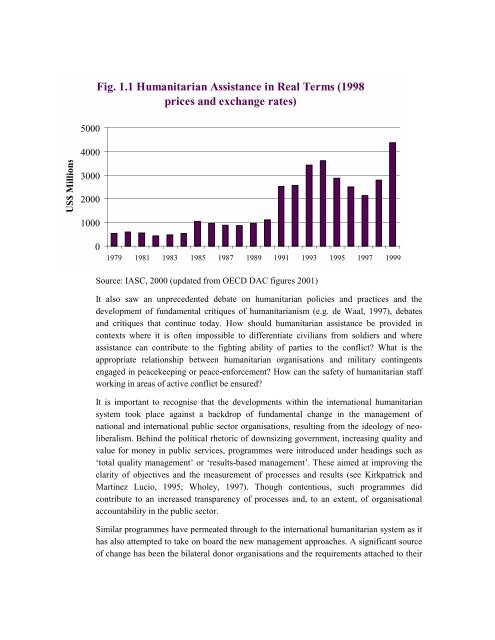Download PDF - ReliefWeb
Download PDF - ReliefWeb
Download PDF - ReliefWeb
You also want an ePaper? Increase the reach of your titles
YUMPU automatically turns print PDFs into web optimized ePapers that Google loves.
US$ Millions<br />
5000<br />
4000<br />
3000<br />
2000<br />
1000<br />
Fig. 1.1 Humanitarian Assistance in Real Terms (1998<br />
prices and exchange rates)<br />
0<br />
1979 1981 1983 1985 1987 1989 1991 1993 1995 1997 1999<br />
Source: IASC, 2000 (updated from OECD DAC figures 2001)<br />
It also saw an unprecedented debate on humanitarian policies and practices and the<br />
development of fundamental critiques of humanitarianism (e.g. de Waal, 1997), debates<br />
and critiques that continue today. How should humanitarian assistance be provided in<br />
contexts where it is often impossible to differentiate civilians from soldiers and where<br />
assistance can contribute to the fighting ability of parties to the conflict? What is the<br />
appropriate relationship between humanitarian organisations and military contingents<br />
engaged in peacekeeping or peace-enforcement? How can the safety of humanitarian staff<br />
working in areas of active conflict be ensured?<br />
It is important to recognise that the developments within the international humanitarian<br />
system took place against a backdrop of fundamental change in the management of<br />
national and international public sector organisations, resulting from the ideology of neoliberalism.<br />
Behind the political rhetoric of downsizing government, increasing quality and<br />
value for money in public services, programmes were introduced under headings such as<br />
‘total quality management’ or ‘results-based management’. These aimed at improving the<br />
clarity of objectives and the measurement of processes and results (see Kirkpatrick and<br />
Martinez Lucio, 1995; Wholey, 1997). Though contentious, such programmes did<br />
contribute to an increased transparency of processes and, to an extent, of organisational<br />
accountability in the public sector.<br />
Similar programmes have permeated through to the international humanitarian system as it<br />
has also attempted to take on board the new management approaches. A significant source<br />
of change has been the bilateral donor organisations and the requirements attached to their
















![CynefinFramework final [Read-Only]](https://img.yumpu.com/19017304/1/190x135/cynefinframework-final-read-only.jpg?quality=85)